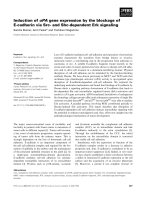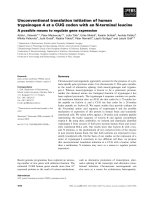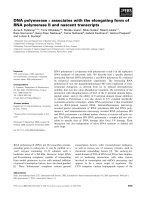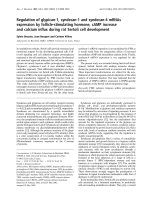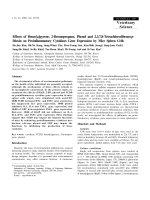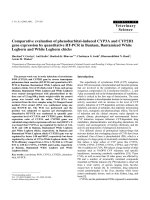Nhp6p and med3p regulate gene expression by controlling the local subunit composition of RNA polymerase II
Bạn đang xem bản rút gọn của tài liệu. Xem và tải ngay bản đầy đủ của tài liệu tại đây (9.67 MB, 203 trang )
NHP6P AND MED3P REGULATE GENE EXPRESSION
BY CONTROLLING THE LOCAL SUBUNIT
COMPOSITION OF RNA POLYMERASE II
XUE XIAO WEI
NATIONAL UNIVERSITY OF SINGAPORE
2007
NHP6P AND MED3P REGULATE GENE EXPRESSION
BY CONTROLLING THE LOCAL SUBUNIT
COMPOSITION OF RNA POLYMERASE II
XUE XIAO WEI
(Bachelor of Engineering (Hons), Beijing Institute of
Technology, People’s Republic of China)
A THESIS SUBMITTED
FOR THE DEGREE OF DOCTOR OF PHILOSOPHY
DEPARTMENT OF MICROBIOLOGY
NATIONAL UNIVERSITY OF SINGAPORE
2007
i
ACKNOWLEDGEMENTS
I would like to express my gratitude to all those who gave me the possibility to
complete this thesis. I am deeply indebted to my supervisor Dr. Norbert Lehming,
whose invaluable guidance, support and encouragement helped me in all the time
of research and writing of this thesis. The completion of this thesis would not have
been possible without his insightful ideas and patience.
I would like to thank Hongpeng, Boon Shang, Zhao Jin, Yee Sun, Wee Leng, Linh
and Mdm Chew for their supports and valuable hints. My appreciation also goes
out to all the lab members, past and present, their care and friendship made the life
here lively and colorful. I would also like to thank my friends Shugui, Xiaoli and
Jiping for all the companionship and encouragements.
Finally, I would like to give my special thanks to my family for their love and
support throughout the course of study.
Table of contents
ii
TABLE OF CONTENTS
Acknowledgements
i
Table of Contents ii
Summary vii
List of Tables viii
List of Figures x
Abbreviations xii
1. INTRODUCTION 1
1.1 Introduction 1
1.2 Aim of the study 9
2. SURVEY OF LITERATURE 10
2.1 Eukaryotic Transcription 10
2.1.1 Transcription of protein-coding genes 10
2.1.2 RNA polymerase II 12
2.1.3 General Transcription Factors 14
2.1.4 Chromatin 18
2.1.5 Histones 20
2.2 Function of histone in eukaryotic transcription 21
2.2.1 Post-translational modification of histone 21
2.2.2 The role of histone modifications in the remodelling of chromatin structure 23
2.3 High Mobility Group (HMG) family proteins 26
2.4 The non-histone chromosomal protein Nhp6p 29
Table of contents
iii
2.4.1 Structure of Nph6p 29
2.4.2 Function of Nhp6p in transcription initiation 32
2.4.3 Function of Nhp6p in transcription elongation 36
2.5 Protein-protein interaction systems 39
2.5.1 Significance of protein-protein interactions 39
2.5.2 GST pull-down assay 41
2.5.3 Yeast two-hybrid system 43
2.5.4 The Split-Ubiquitin system 45
2.5.4.1 The principle of the Split-Ubiquitin system 45
2.5.4.2 Advantages of the Split-Ubiquitin system 48
2.5.4.3 Applications of the Split-Ubiquitin system 48
3. MATERIALS AND METHODS 51
3.1 Materials 51
3.1.1 Plasmids 51
3.1.2 Yeast strains 53
3.1.3 Bacterial strains 54
3.1.4 Primers 55
3.1.5 Buffers 56
3.2 Methods 58
3.2.1 Library Screening 58
3.2.1.1 The Split-Ubiquitin screen 58
3.2.1.2 Preparation of competent yeast cells 59
Table of contents
iv
3.2.1.3 Transformation of plasmids into competent cells 60
3.2.1.4 Plasmid isolation from S. cerevisiae 60
3.2.1.5 Electroporation 62
3.2.1.6 Plasmid Minipreparation from
E. coli 62
3.2.1.7 Restriction endonuclease digestion 63
3.2.1.8 Agarose gel electrophoresis 63
3.2.1.9 Amplification of N
ub
fusion vectors 64
3.2.1.10 Cycle sequencing of N
ub
fusion candidates 65
3.2.1.11 Droplet assay 66
3.2.1.12 Construction of YEplac181-RPB4 and YEplac181-RTT107 66
3.2.2 GST Pull-down assay 68
3.2.2.1 Preparation of GSTp and GST-Nhp6bp 68
3.2.2.2 GST pull-down assay 69
3.2.2.3 SDS-PAGE and Western blot 70
3.2.3 Analysis of phenotype 72
3.2.3.1 Construction of NHP6, RPB4, RTT107 and MED3 deletion strains 72
3.2.3.2 Analysis of 6-AU phenotype 74
3.2.4 Real-time PCR analysis 74
3.2.4.1 Construction of myc-tagged proteins 74
3.2.4.2 Isolation of total RNA 76
3.2.4.3 Reverse-transcription polymerase chain reaction 78
3.2.4.4 Quantitative Real-time PCR 79
Table of contents
v
3.2.5 Chromatin Immunoprecipitation (ChIP) 80
3.2.5.1 Cross-linking of protein-DNA complexes in vivo 80
3.2.5.2 Preparation of chromatin solution 80
3.2.5.3 Determination of chromatin-fragment size 82
3.2.5.4 Immunoprecipitation 82
3.2.5.5 Reversion of cross-link 83
3.2.5.6 Gene specific quantitative PCR 83
3.2.5.7 Quantitative analysis of ChIP PCR products 84
4. RESULTS 85
4.1 Nhp6p-interacting proteins isolated with the Split-Ubiquitin screens 85
4.1.1 Screening for Nhp6p-interacting partners with the Split-Ubiquitin system 85
4.1.2 Restriction endonuclease digestion to check the size of the insert DNA 87
4.1.3 Testing for plasmid linkage 89
4.1.4 DNA sequencing of the isolated Nhp6p-interacting candidates 94
4.1.5 Comparing the interaction strength between the N
ub
fusion proteins
and C
ub
-fusions to Nhp6ap/Nhp6bp and Tpi1p 101
4.2 GST Pull-down assays confirmed the interaction with Nhp6bp 113
4.2.1 N
ub
fusion proteins were expressed in the yeast JD52 cells 113
4.2.2 GST Pull-down assays confirmed the interaction between bacterial
expressed GST-Nhp6bp and yeast expressed candidate proteins 114
4.3 Phenotypes of strains lacking the genes for the non-essential
Nhp6p-interacting proteins 121
4.4 Nhp6p and Med3p repressed ZDS1 transcription by controlling the
Table of contents
vi
local subunit composition of RNA Pol II 124
4.4.1 Nhp6p and its interacting partners repressed expression of ZDS1 124
4.4.2 Myc-tagged fusions of Nhp6bp and its interacting partners were
functional 127
4.4.3 The deletion of
RPB4, RTT107 and MED3 did not affect the
expression of Nhp6bp 130
4.4.4 ChIP analysis determined Nhp6p and its interacting partners Rpb4p
and Med3p at the
ZDS1 chromosomal locus 133
5. DISCUSSION 139
5.1 Novel Nhp6p-interacting proteins were isolated with the help of
the Split-Ubiquitin system 139
5.2 Nhp6p and its interacting proteins regulate gene-transcription 144
5.3 Conclusion 151
5.4 Future work 152
6. REFERENCES 154
7. APPENDICES 177
Summary
vii
SUMMARY
In this project, the Split-Ubiquitin system was used to isolate S. cerevisiae
proteins that interacted with the non-histone chromosomal protein Nhp6p in vivo,
and GST pull-down experiments confirmed eleven of these interactions
in vitro.
Most of the Nhp6p-interacting proteins were involved in transcription and DNA
repair. The ZDS1 gene, whose transcription was repressed by Nhp6p and its
interacting partners Rpb4p and Med3p, was utilized to study their chromosomal
co-localization. Nhp6p, Med3p and the essential RNA polymerase II (RNA Pol II)
subunit Rpb2p were found at the entire ZDS1 locus, while Rpb4p was found at the
ZDS1 promoter only, suggesting that the RNA Pol II that had transcribed ZDS1
was lacking the dissociable Rpb4p subunit. The deletion of NHP6 reduced binding
of Rpb4p to the ZDS1 promoter, while the deletion of MED3 allowed Rpb4p to
enter the ZDS1 open reading frame. This indicates that Nhp6p loaded Rpb4p onto
RNA Pol II at the ZDS1 promoter, while Med3p prevented ZDS1 promoter
clearance of RNA Pol II that contained Rpb4p. Therefore, Nhp6p and Med3p
repressed transcription of ZDS1 by controlling the local subunit composition of
RNA Pol II. On the other hand, Nhp6p generally supports transcription elongation,
as suggested by the 6-AU phenotype of the NHP6 deletion strain. The deletion of
RPB4 reduced growth on 6-AU plates and the over-expression of Rpb4p
suppressed the 6-AU phenotype of the NHP6 deletion strain, indicating that
Nhp6p generally supported transcription elongation via Rpb4p.
List of tables
viii
LIST OF TABLES
Title Page
Table 2.2.1
Different classes of Modifications identified for Histones 22
Table 3.1.4
List of primers used in gene cloning, PCR and ChIP assays 55
Table 3.2.1.3
Components of transformation reaction 60
Table 3.2.1.7
Components of restrict endonuclease reaction 63
Table 3.2.1.10
Contents in cycling sequencing reaction 65
Table 3.2.2.3
Contents of separating and stacking gels for SDS-PAGE 72
Table 3.2.4.2
Contents in gene-specific PCR 78
Table 3.2.4.3
Contents in reverse transcription PCR 78
Table 3.2.4.4
Contents in quantitative real-time PCR 80
Table 3.2.5.6
Contents in ChIP quantitative PCR 84
Table 4.1.3.1
The 34 N
ub
fusion candidates isolated from the
S. cerevisiae genomic library showed plasmid-linkage with
Nhp6-C
ub
-Rura3p in JD52
90
Table 4.1.3.2
Seven of the 34 N
ub
fusion candidates isolated from the
S. cerevisiae genomic library showed FOA resistance in
JD55
93
Table 4.1.4.1
Sequencing results of the N
ub
candidates isolated from the
S. cerevisiae genomic library screens using
Nhp6a-C
ub
-Rura3p or Nhp6b-C
ub
-Rura3p as bait
96
Table 4.1.4.2
Summary of the N
ub
candidates isolated from the
S. cerevisiae genomic library screens using
Nhp6-C
ub
-RUra3p as bait
98
Table 4.1.4.3
Description of the N
ub
fusions isolated from a collection of
N
ub
fused transcription factors using Nhp6a-C
ub
-RUra3p as
bait
100
List of tables
ix
Table 4.1.5.3
Average scores between the interactions of the C
ub
fusion
Nhp6ap and the 24 N
ub
fusions
110
Table 4.1.5.4
Average scores between the interactions of the C
ub
fusion
Tpi1p and the 24 N
ub
fusions
111
Table 4.1.5.5
The final scores for Nhp6a-C
ub
-RUra3p and 24 N
ub
fusions 112
Table 4.2.2
Summary of the Western blot and GST pull-down assays
with the isolated N
ub
fusion proteins
120
List of Figures
x
LIST OF FIGURES
Title Page
Figure 2.5.4.1
Identification of protein-protein interaction with the
split-ubiquitin system
47
Figure 3.2.3.1
Mechanism of homologous recombination 73
Figure 3.2.4
Mechanism of myc-tagged protein replacement 76
Figure 4.1.1
Steps taken to screen and identify N
ub
fusion candidates
which interacted with Nhp6-C
ub
-RUra3p in library
screening
86
Figure 4.1.2
Gel electrophoresis photo showing N
ub
insert sizes in 2%
agarose gel
88
Figure 4.1.5.1
Droplet assays to determine the interaction between
Nhp6a-Cub-RUra3p and the Nub fusion candidates
isolated from the S. cerevisiae genomic library in JD52
103
Figure 4.1.5.2
Droplet assays to determine the interaction between
Nhp6a-C
ub
-RUra3p and the N
ub
fusion transcription
factors in JD52
104
Figure 4.1.5.3
Droplet assays to determine the interaction between
Tpi1p-C
ub
-RUra3p and the N
ub
fusion candidates in JD52
106
Figure 4.2.1
Expression of 11 N
ub
fusion proteins in JD52 114
Figure 4.2.2A
GST Pull-down experiments confirmed the interactions
between Nhp6bp and N
ub
-Rpb4 (99-221)p, N
ub
-Rtt107
(724-1070)p, N
ub
-Med3-DsRed1p in vitro
118
Figure 4.2.2B
GST Pull-down experiments confirmed the interactions
between Nhp6bp and N
ub
-Srp14 (119-146)p, N
ub
-H3,
N
ub
-Tfb4-DsRed1p in vitro
118
Figure 4.2.2C
GST Pull-down experiments confirmed the interactions
between Nhp6bp and N
ub
-H4, N
ub
-H2B, N
ub
-H2A in vitro
119
List of Figures
xi
Figure 4.2.2D
GST Pull-down experiments confirmed the interactions
between Nhp6bp and N
ub
-Tfb1-DsRed1p, N
ub
-Tfg2p in
vitro
119
Figure 4.3
Nhp6bp and Rpb4p support transcription elongation 123
Figure 4.4.1
Nhp6p, Rpb4p, Rtt107p and Med3p repressed
transcription of the
ZDS1 gene
126
Figure 4.4.2
Function of myc-tagged Nhp6bp, Rpb4p, Med3p and
Rtt107p
129
Figure 4.4.3
Expression of myc-tagged Nhp6bp, Rpb4p, Med3p,
Rpb2p and Rtt107p
132
Figure 4.4.4A
Nhp6b-myc9p, Med3-myc9p, Tfb1-myc9p and
Tfb4-myc9p were detected at the
ZDS1 promoter and
ORF in wild type cells
134
Figure 4.4.4B
Association of Nhp6b-myc9 to the ZDS1 locus in wild
type and deletion strains
137
Figure 4.4.4C
Association of Med3-myc9p to the ZDS1 locus in wild
type and deletion strains
137
Figure 4.4.4D
Association of Rpb4-myc9p to the ZDS1 locus in wild
type and deletion strains
138
Figure 4.4.4E
Association of Rpb2-myc9 to the ZDS1 locus in wild type
and deletion strains
138
List of abbreviations
xii
LIST OF ABBREVIATIONS
AD activating domain
6-AU 6-azauracil
BD binding domain
CAK cyclin-activating kinase
ChIP chromatin immunoprecipitation
CHL Chloramphenicol
C
ub
C-terminal half of ubiquitin
CTD carboxy-terminal domain
dNTP deoxyribonucleotide tri-phosphate
FOA 5-fluorooratic acid
FRET fluorescence resonance-energy transfer
GEMs gene expression machines
GST glutathione S-transferase
GTFs general transcription factors
HA Haemagglutinin
HATs histone acetyltransferases
HDACs histone deacetyltransferases
HMG high mobility group
HMTs histone methyltransferases
LB Luria Bertani
List of abbreviations
xiii
NBD nucleosomal binding domain
NER nucleotide excision repair
N
ub
N-terminal half of ubiquitin
ORF open reading frame
PCR polymerase chain reaction
PIC preinitiation complex
PPI protein-protein interaction
PTMs post-translational modifications
RNA Pol II RNA polymerase II
RUra3 orotidine-5’phosphate decarboxylase reporter modified to
begin with an arginine residue
SAGA Spt-Ada-Gcn5-acetyltransferase
SDS sodium dodecyle sulfate
SPR surface plasmon resonance
TAFs TBP-associated factors
TBP TATA-binding protein
TCR transcription coupled repair
TEMED N, N, N’, N’-tetramethlethylene-diamine
TSS transcription start site
UAS upstream activating sequence
UBPs ubiquitin-specific proteases
URS upstream repression sequence
CHAPTER 1
INTRODUCTION
Chapter 1 Introduction
1
1. Introduction
1.1 Introduction
Expression of protein-coding genes in eukaryotic cells is tightly related to
environmental stimulation, life cycle of the organisms and genetics of the species.
Transcription of protein-coding genes is a complicated process that requires the
concerted functions of multiple proteins and transcription factors. Protein-coding
genes consist of a transcription start site, TATA box and sequences such as the
upstream activating sequences (UAS), enhancer, upstream repression sequences
(URS) and silencers, which can be bound by transcriptional regulators (Lee and
Young, 2000).
Transcriptional activation often occurs upon the binding of an activator to an
upstream activating sequence linked to a gene (Ptashne, 2005). Upon transcription
initiation, the activator binds to proximal promoter elements or more distal
regulatory sequences (i.e., enhancers). Promoter-bound activators then recruit
chromatin modifying and remodelling complexes that switch the chromatin
structure of the gene from an
off state to an on state (Daniel and Grant, 2007). The
activator also recruits and/or activates the transcription machinery, which include
RNA polymerase II (RNA Pol II), the General Transcription Factors (GTFs) and
the Mediator, a complex of about twenty proteins that is conserved from yeast to
human (Kornberg, 2005). Transcriptional repression often occurs upon the
binding of a repressor to a silencing region linked to a gene (Courey and Jia,
Chapter 1 Introduction
2
2001). Upon repression, the transcriptional repressor binds to promoter elements
or repression regions (e.g., silencers) to block the RNA polymerase machinery and
result in a decrease of transcription activity. The repressor also recruits chromatin
modifying and chromatin remodeling complexes that switch the chromatin
structure of a gene from the
on state to the off state (Jacobson et al., 2004). The
Mediator plays a key role in activation, bridging DNA-bound activators, the
general transcriptional machinery, especially RNA polymerase II and proteins
bound to the core promoter. The Mediator subunits are necessary for a variety of
positive and negative regulatory processes and serve as the direct targets of
activators themselves (Lewis and Reinberg, 2003). The Mediator components
Med3p and Srb7p have been described as direct repressor targets
(Papamichos-Chronakis et al., 2000; Gromöller and Lehming, 2000). Santangelo
(2006) proposed a new model called “reverse recruitment” to explain the
eukaryotic transcriptional activation and repression. This model states a link
between transcription regulation and nuclear periphery. According to the reverse
recruitment hypothesis, the proteins required for gene transcription are part of
gene expression machines (GEMs) (Maniatis and Reed, 2002) in the nuclear
periphery and uninduced genes are located in the centre of the nucleus. Upon gene
induction, an activator recruits the gene to a GEM that is associated with a nuclear
pore, the gene is transcribed, and the mRNA is exported out of the nucleus
through the associated nuclear pore (Casolari et al., 2004). Upon gene repression,
a repressor recruits the gene to a GEM that is not associated with a nuclear pore
Chapter 1 Introduction
3
and the gene is silenced by the SIR complex, which is associated with repressive
GEMs (Sarma et al., 2007).
High mobility group (HMG) proteins, present in all tissues of eukaryotes, are an
abundant class of chromosomal proteins facilitating assembly of higher order
strucutures (Aleporou-Marinou et al., 2003). HMG proteins act as architectural
factors in the nucleus, facilitating various DNA-dependent processes such as
transcription and recombination (Bustin et al., 1990). There are three HMG
protein families which have been classified due to their characteristic primary
structures: the HMGB protein family, the HMGN protein family and the HMGA
protein family. Each of these protein families contains distinct sequence motifs.
The HMGB family is the most abundant HMG family, which are distinguished by
the presence of one or two copies of the HMG-box which is responsible for DNA
binding (Lu et al., 1996). The general property of HMG proteins is to bend or
wrap DNA (Giese et al., 1992). The HMG proteins are required for efficient gene
activation due to their ability to promote assembly of preinitiation complexes.
They play a general role in controlling chromatin structure and a specific role in
controlling transcription and DNA replication. HMGB proteins are
non-sequence-specific DNA-binding proteins. They bend DNA strands to
facilitate the formation of higher order DNA-protein structures which are required
for transcription initiation (Tremethick and Molley, 1996; Tremethick and
Molley, 1998).
Nhp6p is an architectural transcription factor that is related to the high-mobility
Chapter 1 Introduction
4
group B family of non-histone chromosomal proteins that bend DNA sharply
(Travers, 2003). In Saccharomyces cerevisiae, Nhp6p is encoded by two highly
homologous genes, NHP6A and NHP6B. They are very similar and functionally
redundant (Formosa et al., 2002). Nhp6p contains a single 70-residue HMG-box
motif of the type found in the HMGB family, and it is homologous to the middle
segment of the chromatin-associated high mobility group B protein from calf.
Nhp6p shares certain biological functions with HMGB proteins. Nhp6p binds to
the minor groove of double-stranded DNA in a non-sequence-specific manner
(Masse et al., 2002) and contributes to stabilize bent DNA confirmations within
the preinitiation complexes (Lopez et al., 2001). Loss of Nhp6p leads to increased
genomic instability, hypersensitivity to DNA-damaging agents, and shortened
yeast cell life span (Giavara et al., 2005). In addition, both Nhp6ap and Nhp6bp
contain a highly basic amino acid region that precedes the HMG box, which
confers Nhp6p a higher affinity to bend DNA more efficiently than mammalian
HMGB proteins.
Transcriptional activation requires the recruitment of the transcription
machinery, which consists of RNA polymerase II (RNA Pol II), the General
Transcription Factors (GTFs) and the Mediator (Kornberg, 2005). The critical step
in transcriptional activation by RNA polymerase II is the formation of the
preinitiation complex, which contains the TBP-TFIIA-TFIIB-DNA complex. This
complex recruits RNA polymerase II and other general transcription factors
required for transcriptional initiation (Biswas et al., 2004; Biswas et al., 2006).
Chapter 1 Introduction
5
Nhp6p supports transcription initiation by facilitating the formation of the
TFIIA-TBP-TATA complex. The binding of Tbp1p to DNA is a two-step process,
starting with an unstable complex containing unbent DNA and then slowly
isomerizing into a stable complex with bent DNA. Nhp6 proteins bend DNA and
promote formation of the stable TBP-bent DNA complex. TFIIB also stimulates
the formation of the stable TBP-DNA complex and its association with this
complex plays an important role to maintain the bent DNA form. Nhp6p increases
the affinity of TFIIB association to the TBP-TFIIA-DNA complex (Yu et al.,
2003). Nhp6p regulates both the positive and negative transcription of a number
of RNA polymerase II-transcribed genes in a variety of cellular processes. A
genome-wide analysis of cells lacking NHP6A/B showed that 114 genes were
up-regulated and 83 genes were down-regulated in an nhp6a nhp6b double
mutant, indicating an important role for Nhp6p in chromatin-mediated gene
regulation (Moreira and Holmberg, 2000). Nhp6p is involved in the transcriptional
activation of HO, FRE2, CUP1, CYC1, URA3, DDR2 and DDR8 (Cosma et al.,
1999; Fragiadakis et al., 2004; Paull, 1996). It also plays a role in the transcription
repression of GAL1, SUC2 (Laser et al., 2000) and CHA1 (Moreira and Holmberg,
2000).
Nhp6p functions with the yeast FACT complex to promote transcriptional
elongation (Formosa et al., 2001). Chromatin modulator FACT was identified to
mediate the transcription of protein-coding genes by RNA polymerase II and
works at the level of transcriptional elongation. The FACT complex acts as a
Chapter 1 Introduction
6
histone chaperone to promote H2A-H2B dimer dissociation from the nucleosome
and allow RNA polymerase II move along the DNA template (Belotserkovskaya
and Reinberg, 2004). The chromatin remodeller FACT has two main subunits.
The larger one is Spt16p, and the smaller one is SSRP1(vertebrates) or Pob3p
(yeast). Yeast Pob3p protein is structurally related to SSRP1 proteins but lacks the
HMG-box domain at the C-terminus of SSRP1. The function of this domain for
yeast FACT is supplied by the small yeast HMG-box protein Nhp6p (Wittmeyer
and Formosa, 1997). Nhp6p is involved in a two-step nucleosome remodelling
mechanism: multiple Nhp6p molecules bind to the nucleosome first and induce a
change in nucleosome structure to convert it to a substrate for Spt16p-Pob3p or
other chromatin-modifying factors; then these Nhp6p-nucleosomes recruit
Spt16p-Pob3p to form SPN-nucleosomes (Ruone et al., 2003). The complex of
Spt16p-Pob3p and Nhp6p (yFACT) with nucleosomes causes changes in the
electrophoretic mobility and nuclease sensitivity of the nucleosomes (Formosa et
al., 2002). In this way, Nhp6p promotes the formation of the yeast FACT complex
to facilitate transcriptional elongation.
In addition, Nhp6p is reported as a transcriptional initiation fidelity factor for
RNA polymerase III transcription in vitro and in vivo (Kassavetis and Steiner,
2006). Nhp6p participates in the activation of the RNA Pol III SNR6 gene (Lopez
et al., 2001) and the nhp6a nhp6b double mutant is temperature sensitive due to
inefficient transcription of the essential SNR6 gene by RNA Pol III (Kruppa et al.,
2001). Nhp6p is important for transcription of a set of tRNA genes and
Chapter 1 Introduction
7
heterochromatin barrier function (Braglia et al., 2007). Nhp6p also plays a role in
DNA repair and genome maintenance (Giavara et al., 2005).
RNA polymerase II catalyzes the transcription of DNA to synthesize the
precursors of mRNA and small nuclear RNAs that take part in RNA splicing
(Lewin, 2004). A wide range of transcription factors are required for RNA Pol II
to bind to its promoters and begin transcription. Transcriptional activators recruit
RNA polymerase II combined with specific transcription factors and other
auxiliary proteins to form the preinitiation complex, which directs transcription
from specific promoters (Hahn, 2004). RNA Pol II of S. cerevisiae is composed of
twelve subunits designated Rpb1p–12p, ranged in size from approximately 6 kd to
200 kd (Young, 1991; Levine and Tjian, 2003). Rpb1p, Rpb2p, Rpb3p and
Rpb11p are responsible for the basic catalytic activity; Rpb5p, Rpb6p, Rpb8p,
Rpb10p and Rpb12p constitute the bulk of RNA Pol II structure and maintain
structural integrity (Choder, 2004; Sampath and Sadhale, 2005); Rpb9p influences
start site selection (Hampsey, 1998). These ten subunits form the core of RNA Pol
II. Rpb4p and Rpb7p form a conserved complex and perform multiple functions in
transcription, mRNA transport and DNA repair (Edwards et al., 1991). The
Rpb4p/Rpb7p subcomplex of RNA Pol II interacts with transcriptional activators
and the general transcription factors TFIIB and TFIIF to promote the assembly of
the initiation complex in the promoter region (Choder, 2004). Rpb4p is a
non-essential subunit of the RNA Pol II. It is not essential for cell viability, but
cells lacking RPB4 exhibit slow growth at moderate temperature, poor recovery
Chapter 1 Introduction
8
from stationary phase and are sensitivity to extreme temperatures (Woychik and
Young, 1989; Choder and Young, 1993; Rosenheck and Choder, 1998). Rpb4p
has some unique features distinguishing it from other subunits. The stoichiometry
of Rpb4p is dependent upon growth conditions. In optimally growing cells, the
fraction of RNA Pol II containing Rpb4p is approximately 20%, and it gradually
increases following the shift to post-logarithmic phases (Kolodziej et al., 1990;
Choder and Young, 1993).
The Split-Ubiquitin system was originally developed by Johnsson and Varshavsky
(1994). It is an alternative yeast two-hybrid assay that is based on a conditional
proteolysis design (Lehming, 2002; Reichel and Johnsson, 2005). The
Split-Ubiquitin system is based on conditional proteolysis that occurs upon the
re-association of the N- and C-terminal halves of ubiquitin designated N
ub
and
C
ub
, respectively. Each half of ubiquitin is fused to either protein of interest. In our
split-ubiquitin screen, the bait protein Nhp6ap or Nhp6bp was fused to C
ub
immediately followed by the reporter protein RUra3p. The first residue of Ura3p
had been changed to arginine to cause the degradation of the free RUra3p reporter
by the enzymes of the N-end rule. The URA3 gene encodes orotidine-5'-phosphate
decarboxylase. This enzyme is required for biosynthesis of uracil. It also converts
non-toxic 5-fluoroorotic acid (FOA) to 5-fluorouracil. The new product is highly
toxic and causes cell death. A N
ub
fusion library had been constructed by fusing
genomic S. cerevisiae Sau3A-partially digested DNA fragments in all three
reading frames 3’ to the N
ub
moiety. The N
ub
fusion library was transformed into a
Chapter 1 Introduction
9
S. cerevisiae strain that expressed Nhp6a-C
ub
-RUra3p or Nhp6b-C
ub
-RUra3p as
bait. When the N
ub
fusion protein interacted with the C
ub
fusion protein inside the
cell, the two halves of ubiquitin were brought together to form a native-like
ubiquitin. Ubiquitin-specific proteases (UBPs) recognized the reconstituted
ubiquitin and cleaved off RUra3p. The enzymes of the N-end rule degraded the
released RUra3p rapidly. Thus the interaction between N
ub
and C
ub
fusion proteins
within the cells could be indicated by the FOA resistance.
1.2 Aim of the study
Our research is focused on the isolation and identification of new interacting
partners of the non-histone chromosomal protein Nhp6p. The purpose of this
study is to investigate how these cooperator proteins function together with Nhp6p
to regulate specific gene transcription in yeast. We have isolated
Nhp6p-interacting proteins using the Split-Ubiquitin system. We have used the
ZDS1 gene, which is repressed by Nhp6p and its interacting partners to study
chromosomal co-localization of Nhp6p and its interacting partners in wild-type
and deletion strains. Our study will provide further understanding of how
non-histone chromosomal proteins are involved in the regulation of transcription
and how they cooperate with their associated proteins to regulate gene expression.
